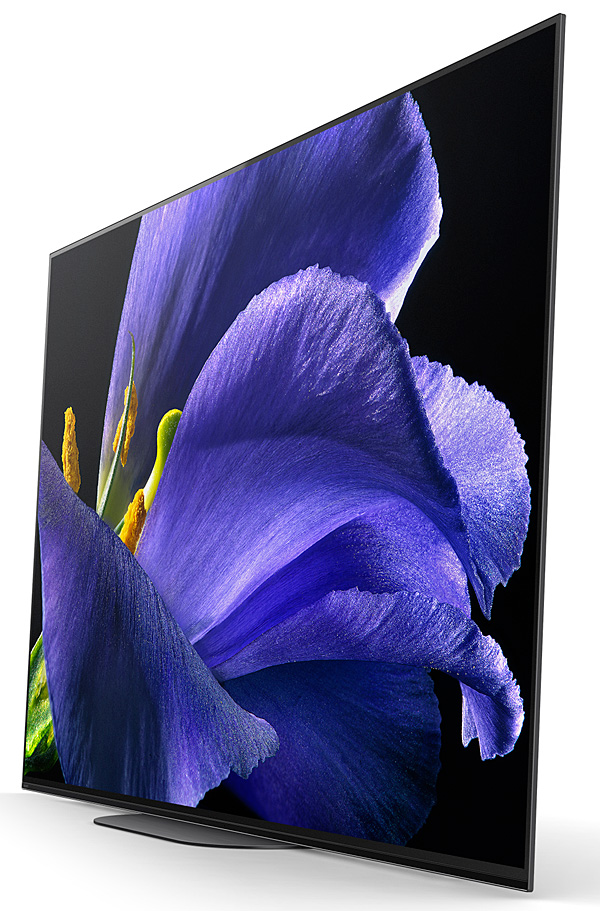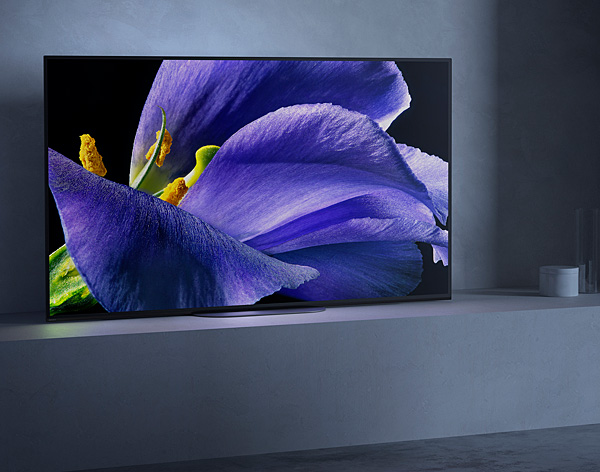Sony Bravia XBR-65A9G OLED Ultra HDTV Review Page 2
Done this way, the results weren't quite as precise as when I did a full manual HDR calibration, but they came acceptably close. That's a good thing, too, since you can't manually enter separate color settings for SDR and HDR—any attempt to manually reset the color settings in HDR will alter the previously entered SDR calibration settings as well (a good argument for recording your manual SDR settings and storing them in a safe place).
The A9G lacks a "copy to all inputs" feature, so you'll need to enter your settings manually for each input and streaming app you plan to use. And the settings that you enter for one streaming app—Netflix, for example—don't automatically carry over for other ones such as YouTube, so you'll need to set that up separately as well.

HD and Standard Dynamic Range Performance
All discs used in this review were played on an Oppo UDP-203 Ultra HD Blu-ray player. A full black test pattern was unmeasurable on the Sony with our test gear in SDR mode, and barely measurable in HDR mode. In either SDR or HDR a full-field black screen was completely black during actual viewing, as were the black bars on letterboxed films.
I never saw posterization or false contouring on any of the programs I watched, nor was there any obvious "streaking," "dirty screen" effect, or other uniformity issues (though these issues can vary with the specific sample of any flat-panel set). As with all OLED screens, off-center viewing produced no visible change in picture quality.
The Sony passed our standard (1080i and 1080p) suite of video tests. It outputs multichannel lossy audio from its optical digital output with Dolby Digital sources, but only stereo sound with DTS. The set's enhanced audio return channel (eARC) option, however, makes this limitation less significant than in the past.
I watched hours of HD/SDR programming both from Blu-ray discs and streaming sites, the latter primarily Netflix and YouTube. YouTube video quality is often bad, but at its best it can be exceptional, particularly with movie trailers. High-quality Netflix programming was also beyond serious criticism, something I wouldn't have imagined possible with streaming sources less than two years ago. Nevertheless, I still rely on Blu-ray to make definitive judgments.
 The Blu-ray music video Legends of Jazz with Ramsey Lewis looked stunning on the Sony. The skin tones were believable if slightly warm, although that's to be expected with stage lighting. Instruments glistened, image depth and saturation were spot on, and detail was clear enough from just under 8 feet from the screen to read the label on the AKG microphone (C414 ED, Made in Austria!) used for flautist Dave Valentin's "Obsession."
The Blu-ray music video Legends of Jazz with Ramsey Lewis looked stunning on the Sony. The skin tones were believable if slightly warm, although that's to be expected with stage lighting. Instruments glistened, image depth and saturation were spot on, and detail was clear enough from just under 8 feet from the screen to read the label on the AKG microphone (C414 ED, Made in Austria!) used for flautist Dave Valentin's "Obsession."
Continuing with music on Blu-ray, the 2014 New Year's Concert, featuring the Vienna Philharmonic, is both an audio and video feast, the former well-handled by the Sony's Acoustic Surface audio. The concert took place in Vienna's Musikverein, rated as one of the best concert halls in the world and perhaps the most visually stunning.
With its gold-studded decor illuminated by glistening chandeliers, it's often referred to as the Golden Hall. Viewed on the A9G, the shots of the hall itself, and of the musicians with their gleaming instruments (particularly the brass), could easily fool even an expert into believing that this was an HDR disc rather than standard HD/SDR. The only flaw was a bit of strobing on the organ pipes as the camera panned across them. (This was likely in the source, as it was present whether 4K upconversion was handled by the Sony, as it was for all of the HD/SDR material referenced here, or by my Oppo UDP-203 player.)
Movies in HD/SDR on Blu-ray fared equally well on the A9G. Casanova, an underappreciated 2005 farce (not a historically accurate bio!), is set in Renaissance-era Venice. While perhaps a step below the glossiest films on disc, the period costumes, and the scenes shot in and around the beautiful city of Venice, looked engaging on the Sony. The Baroque music score, which doesn't feature the sort of bassline that the Sony can't muster, was rewarding as well when played through the set.
If you do want genuine gloss, Disney's animated Frozen offers it by the truckload. Animation rarely looks bad on any reasonably competent display, but there's no question that the Sony offered more than the usual helping of gorgeous images from this disc, which looked amazing in every way.
Ultra HD and High Dynamic Range Performance
As with HD/SDR, I watched both streamed and disc-based source material in Ultra HD/HDR. The streaming was mainly from Netflix in Dolby Vision. Lost in Space, The Umbrella Academy, Stranger Things, Altered Carbon, and The Bird Box all looked exceptionally good, with impressively bright highlights set off against normal and shadowed backgrounds, the latter as dark as they needed to be without looking crushed.

Both Dolby Vision and HDR10 on disc often looked a bit too dark on the A9G. For the most part I was able to cure this with a one-step increase or higher of the Gamma or Black level controls, and with a small reduction of the Color control in some cases. (You need to be cautious with the Black level control, however, since an increase from just 50 to 51 in a dark room turns a full black screen from total black to a dark but clearly visible gray). Altogether, I sampled nearly 20 Ultra HD Blu-ray titles and only found four—Black Hawk Down, The Dark Knight, Gladiator, and I Am Legend—that needed more correction. These titles clearly looked better in their HD/SDR versions, but even there they exhibited some black crush on dark scenes. (After deadline I found that the new Panasonic DP-UB9000 Ultra HD Blu-ray player reviewed elsewhere in this issue, and perhaps its less pricey siblings as well, offers additional controls that helped significantly with this issue, particularly on Black Hawk Down.
A wide range of titles, including Blade Runner 2049, Passengers, The Great Wall, Allied, Cinderella (2015 live action version), The Greatest Showman, Toy Story 2, and many others all looked eye-popping on the Sony. Some other elements and moments that grabbed my attention: the rich colors in The Great Wall; the incredible detail and use of shading, shadows, and highlights in Blade Runner 2049; the variety of unexpectedly subtle eye-candy in Allied (a WWII melodrama); and the joyful, vividly saturated musical numbers in The Greatest Showman.
Conclusion
Having recently reviewed one of the Sony XBR-65A9G's prime competitors, LG's OLED65E9, what I can say is that both sets run neck and neck by any reasonable standard and differ mainly in features. The LG's peak brightness measured roughly 25 percent higher in HDR mode, though this didn't put the Sony at a disadvantage with bright highlights in any obvious way. The Sony has better built-in audio and its look-up tables make for an easier HDR setup (both sets, however, allow for full automated calibration via CalMAN). The LG 65E9 is also priced the same as the Sony 65A9G.
Without a side-by-side look (I had to send the LG OLED back before reviewing the Sony) I 'm hard pressed to pick a winner. Both sets generated numerous "wows," but those might have been just a little louder with the Sony. That appears to have been the reaction of experts last summer when the A9E and LG's slightly less expensive OLED- 65C9PUA model were pitted against each other in a shootout held annually by retailer Value Electronics near New York City. I wasn't present at that event, but the Sony won—by a nose.




























































